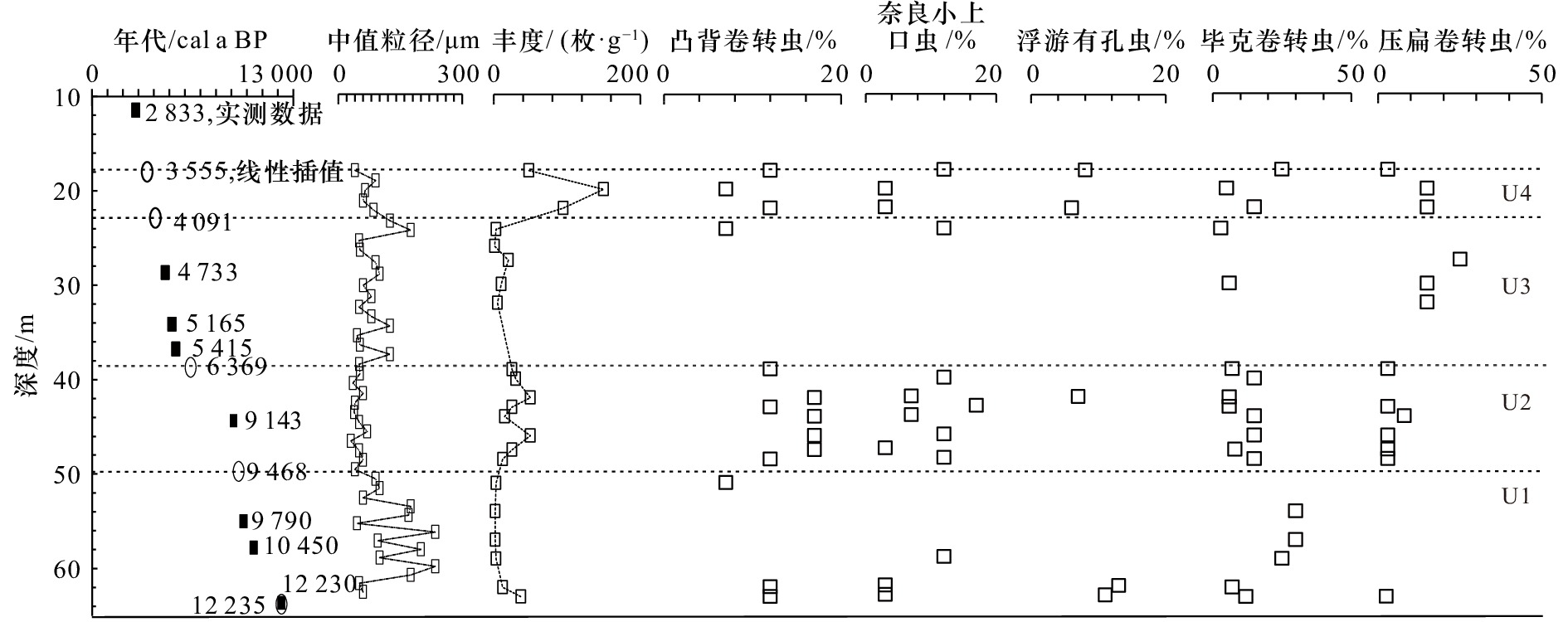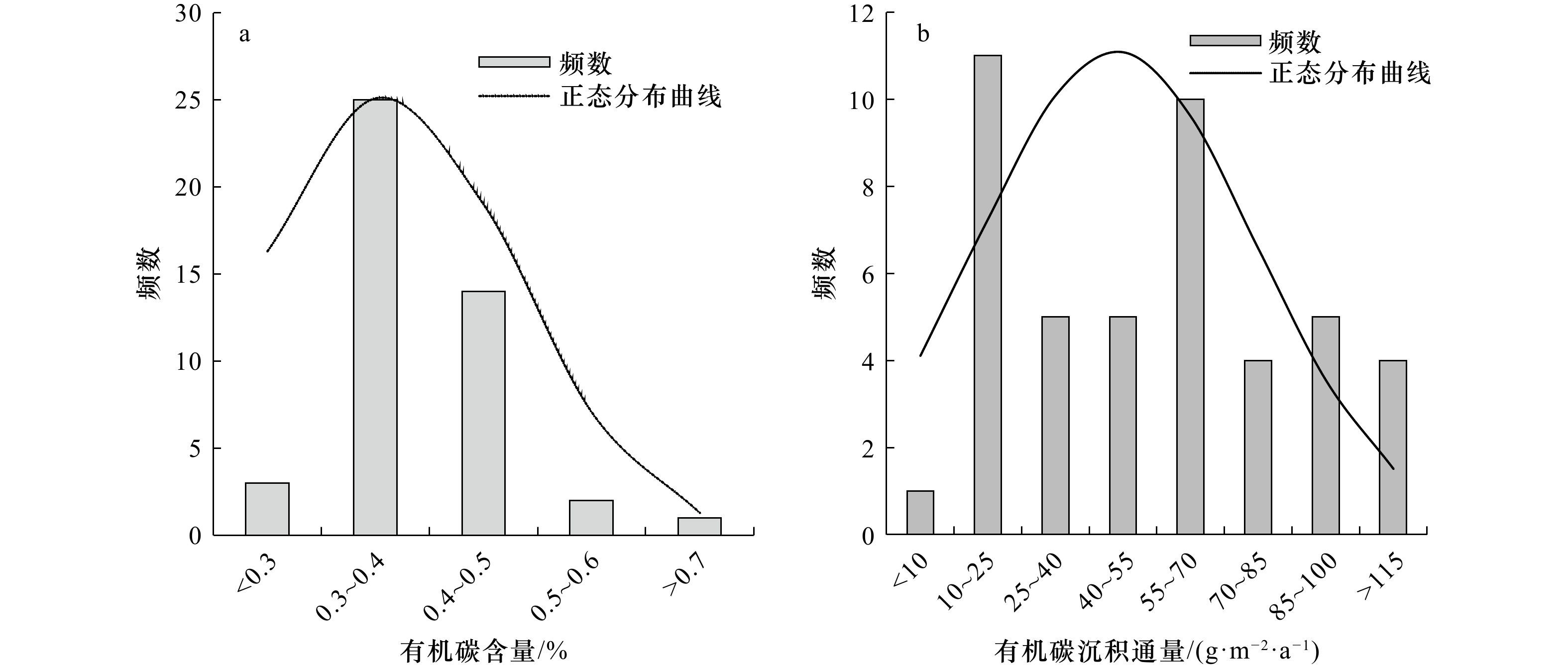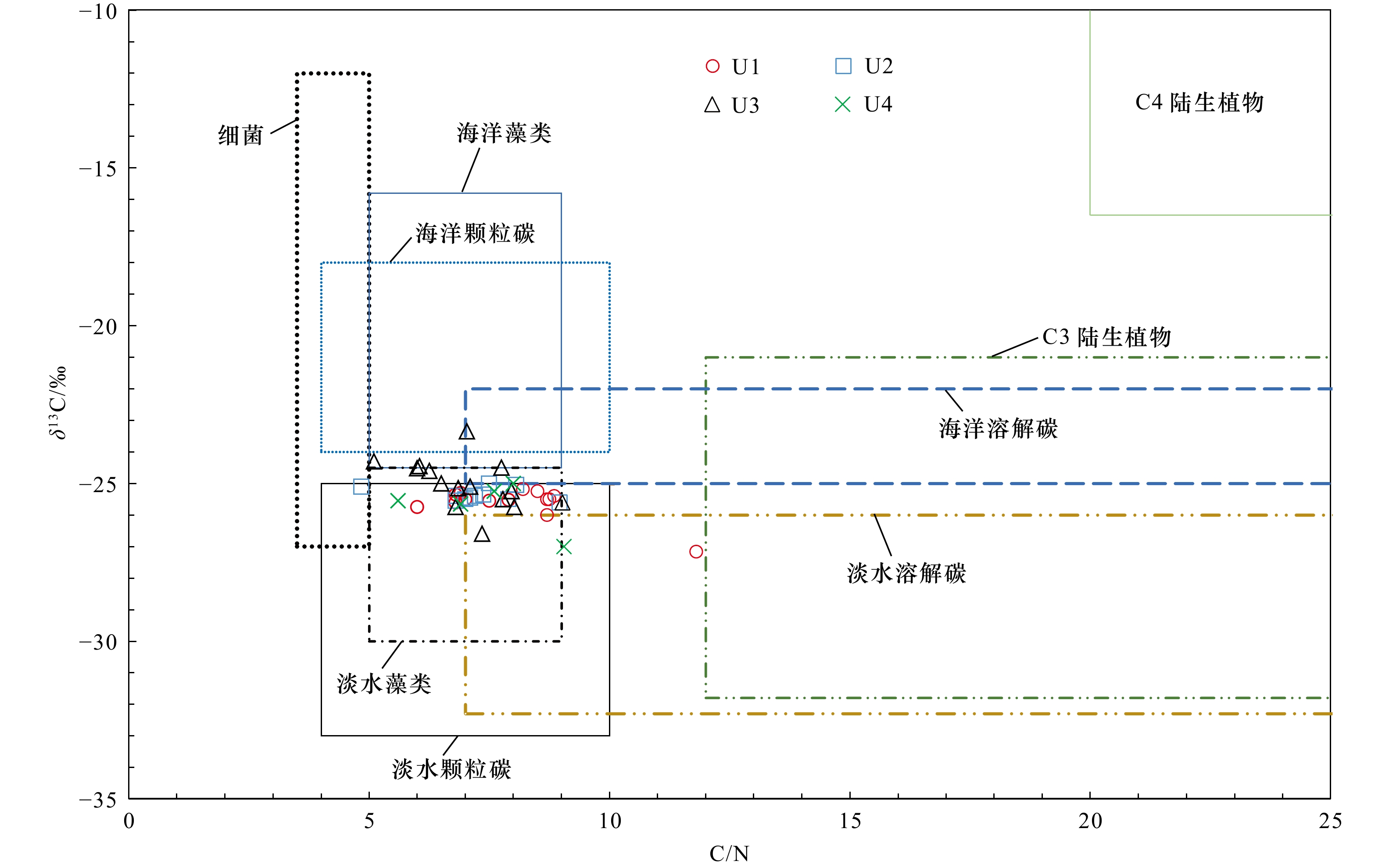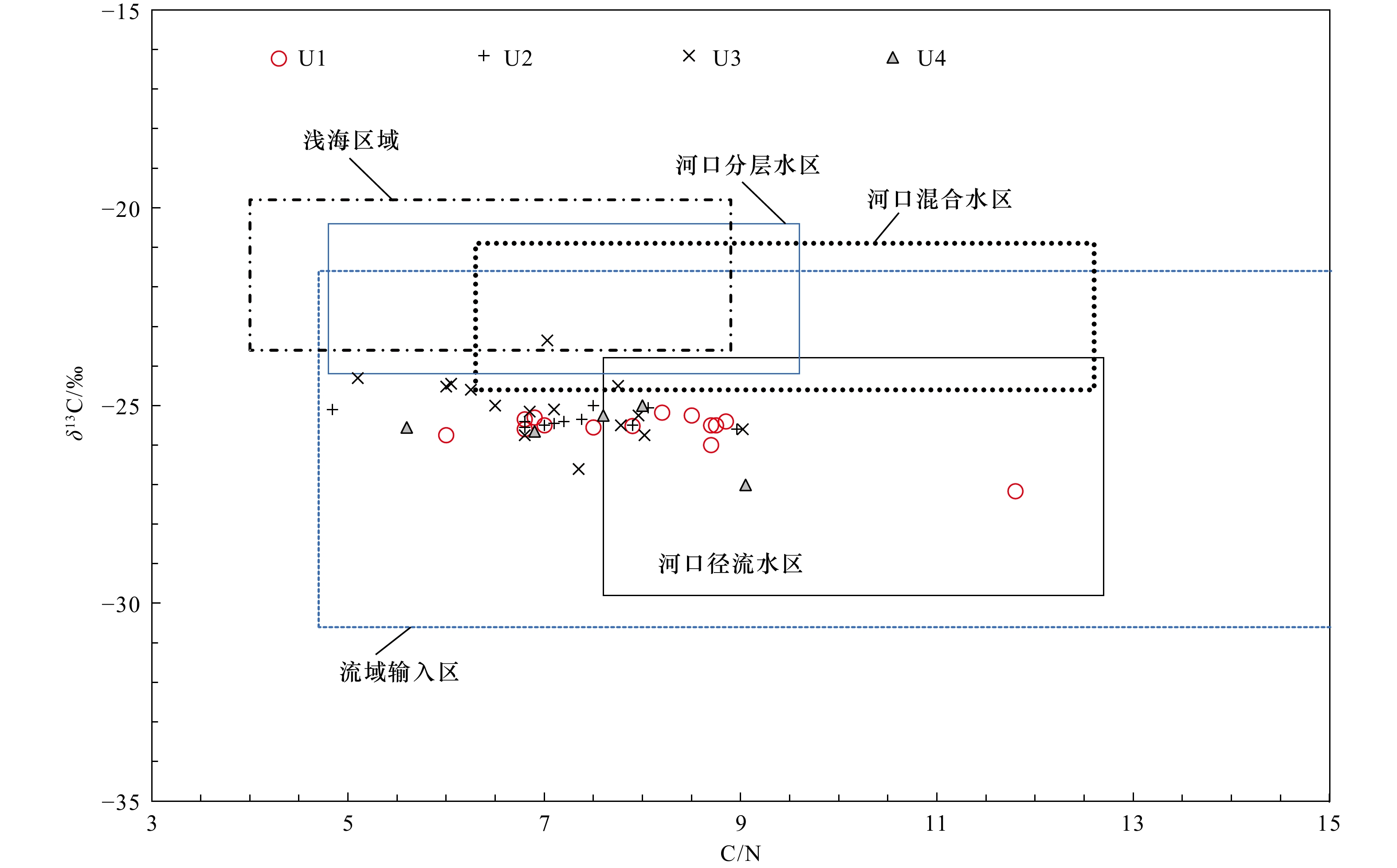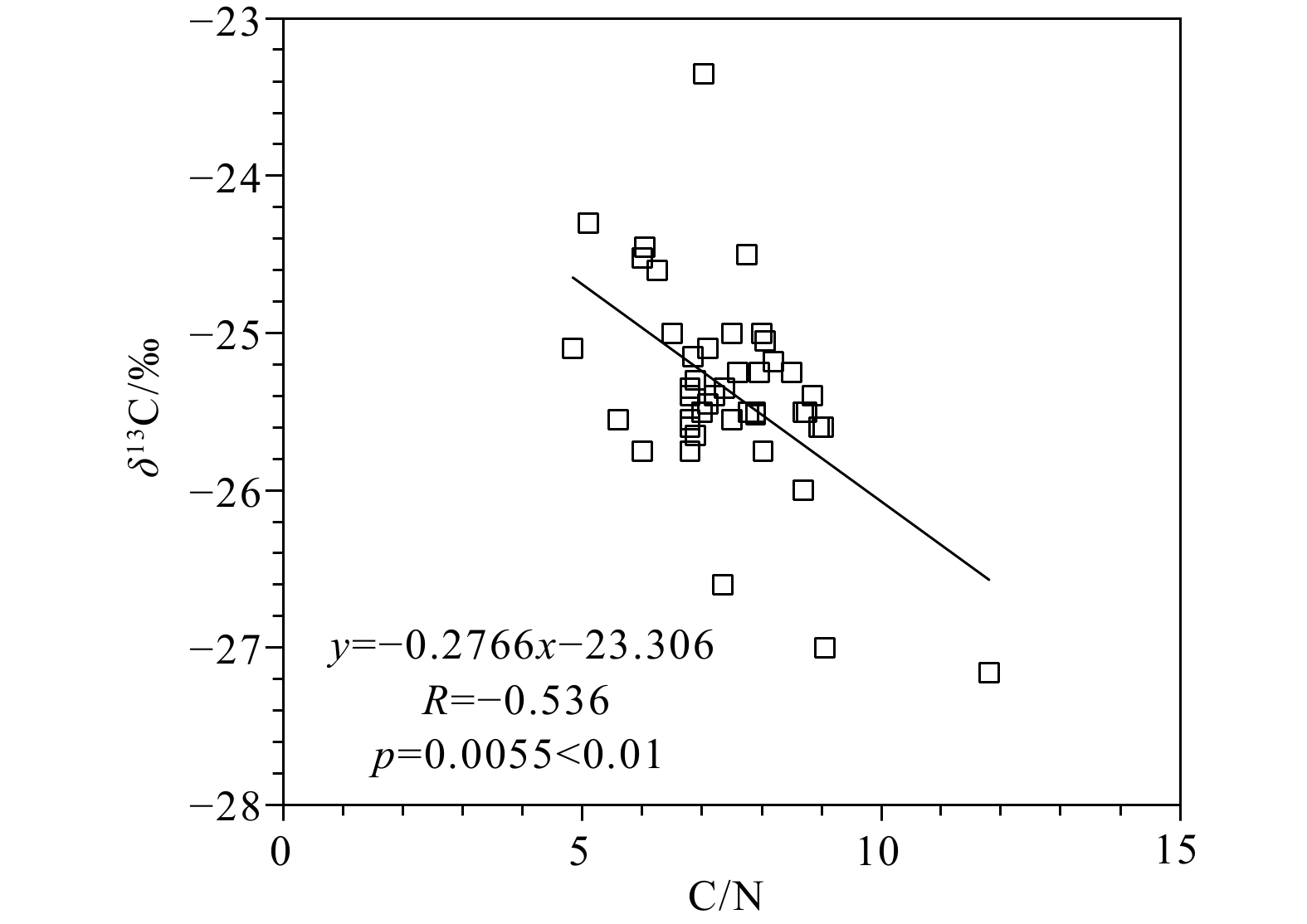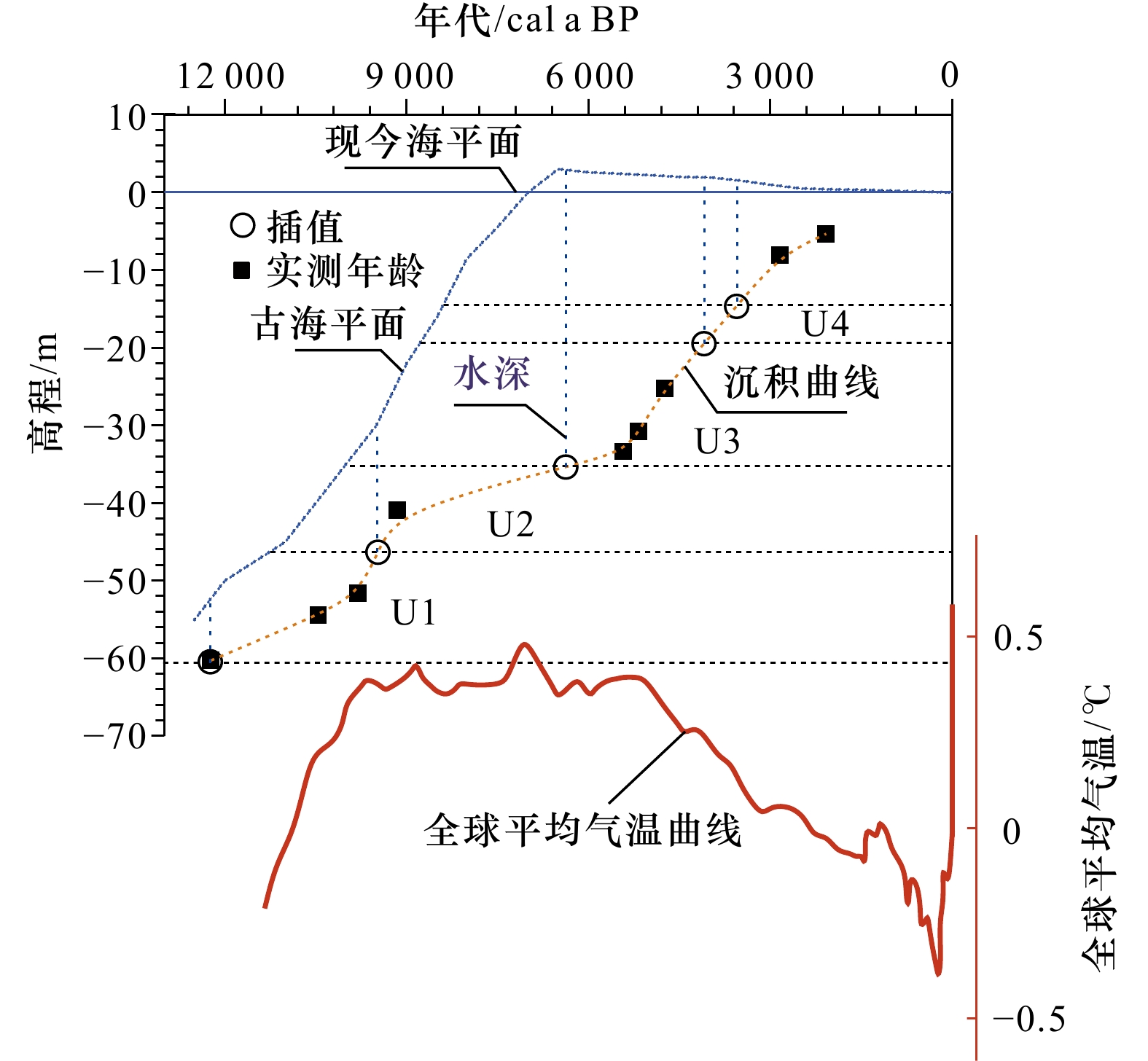Analysis of carbon burial fluxes and sources in early to middle Holocene sediments of the Changjiang River palaeo-valley
-
摘要: 为了研究长江古河谷地区早中全新世沉积物的碳埋藏速率及来源,进行了ZK1孔沉积物总有机碳(TOC)、总氮(TN)及δ13C的测定,结合AMS14C(植物碎屑、贝壳)测年、有孔虫及粒度数据,分析了长江古河谷碳埋藏的时空分布特征与TOC来源。采用历史地理学、沉积地质学结合测年数据进行了年代地层划分,自下而上分别为U1潮汐河道、U2河口湾、U3潮流砂脊和U4前三角洲。沉积物受到水深、径流、河口余环流、潮流、波浪、风暴与再矿化等作用或因素影响,TOC平均值为0.41%,低于长江河口表层沉积物基准值0.46%。ZK1碳埋藏通量(TOCBF)介于7.4~110.5 g/(m2·a)之间,差异较大。TOCBF数值主要受控于沉积速率。δ13C与TOC/TN(C/N) 投影点结果表明,TOC来源表现为多源特征,且整体表现为偏陆源特征。C/N与δ13C线性拟合相关性高,适合采用C/N与δ13C进行TOC来源的定量分析。基于C/N与δ13C采用三端源模型进行了TOC来源分析。U2、U3沉积期处于全新世大暖期,其海源碳与陆源碳较U1、U2沉积单元高,这主要与海洋、陆地初级生产力的提高有关。ZK1海洋浮游植物对TOC的贡献量平均值为31%。河口浮游植物对TOC的贡献量平均值为31%。陆源有机碳对TOC的贡献量平均值为38%。整体来看,陆源有机碳的贡献量大于河口浮游植物与海洋浮游植物的贡献量,这与图解法的分析结果基本一致。Abstract: In order to study the carbon burial rates and sources of early to middle Holocene sediments in the Changjiang River palaeo-valley area, the determination of total organic carbon (TOC), total nitrogen (TN) and δ13C of sediments from ZK1 hole was carried out, and the spatial and temporal distribution characteristics and TOC sources of carbon burial in the Changjiang River palaeo-valley were analyzed by combining AMS14C (plant debris, shells) dating, foraminiferal and grain size data. Using a combination of historical geography and sedimentary geology combined with AMS14C data, the chronostratigraphic classification was carried out from bottom to top as tidal channel (U1), estuarine bay (U2), tidal sand ridge (U3), and pre-delta (U4). Sediments were influenced by the effects or factors of water depth, runoff, estuarine after-circulation, tidal currents, waves, storms and remineralization, and the mean value of TOC was 0.41%, which was lower than the surface layer of the Changjiang River Estuary. The ZK1 hole carbon burial flux (TOCBF) ranged from 7.4 g/(m2·a) to 110.5 g/(m2·a), with large variations. The TOCBF values were mainly controlled by the sedimentation rate. The results of δ13C and TOC/TN (C/N) projection points indicate that there are TOC sources with multi-source characteristics, and the overall performance is partial to terrestrial sources. The linear fit correlation between C/N and δ13C was high, which allowed the quantitative analysis of organic matter sources using C/N and δ13C. The organic carbon source analysis was carried out based on C/N and δ13C using a three-terminal source model. The U2 and U3 depositional periods were in the Holocene Great Warm Period, and the sea-derived and land-derived carbon was higher than that of the U1 and U2 depositional units, which was mainly related to the increase of marine and terrestrial primary productivity. The mean contribution of marine phytoplankton to total organic carbon was 31% in ZK1 hole. The mean contribution of estuarine phytoplankton to total organic carbon was 31%; the mean contribution of terrestrial organic carbon to total organic carbon was 38%. Overall, the contribution of terrestrial organic carbon was greater than that of estuarine phytoplankton and marine phytoplankton, which was basically consistent with the analysis results of the graphical method.
-
Key words:
- organic carbon /
- foraminifera /
- burial rate /
- depositional environment /
- AMS14C
-
表 1 ZK1孔AMS14C年代序列
Tab. 1 AMS14C chronological sequence of ZK1 hole
样品编号 深度/m 岩性 测年材料 校正年龄/(cal a BP) ZK1-1 11.5 灰色粉细砂夹粉质黏土 植物碎屑 2 833 ZK1-2 28.7 灰色泥砂互层 贝壳 4 733 ZK1-3 34.2 灰色泥砂互层 贝壳 5 165 ZK1-4 36.8 灰色泥砂互层 贝壳 5 415 ZK1-5 44.4 灰色粉砂与黏土互层 植物碎屑 9 143 ZK1-6 55.0 灰色粉细砂与黏土互层 植物碎屑 9 790 ZK1-7 57.8 灰色细砂与粉质黏土互层 贝壳 10 450 ZK1-8 63.7 灰色粉质黏土夹粉砂 螺壳 12 230 表 2 不同沉积单元有机碳与总氮拟合特征
Tab. 2 TOC and TN fitting characteristics of different sedimentation units
沉积单元 拟合式 相关
系数TN平
均值/%拟合式截距与TN
平均值的比值/%全部样本 y = 0.063 7x + 0.029 2 0.728 0.055 53 U1 y = 0.059x + 0.029 1 0.848 0.056 52 U2 y = 0.034 5x + 0.039 3 0.302 0.052 75 U3 y = 0.105 4x + 0.015 7 0.751 0.059 27 U4 y = –0.022 9x + 0.056 7 0.192 0.045 126 -
[1] Zonneveld K A F, Versteegh G J M, Kasten S, et al. Selective preservation of organic matter in marine environments; processes and impact on the sedimentary record[J]. Biogeosciences, 2010, 7(2): 483−511. doi: 10.5194/bg-7-483-2010 [2] Kuzyakov Y, Friedel J K, Stahr K. Review of mechanisms and quantification of priming effects[J]. Soil Biology and Biochemistry, 2000, 32(11/12): 1485−1498. [3] Hu Limin, Shi Xuefa, Yu Zhigang, et al. Distribution of sedimentary organic matter in estuarine-inner shelf regions of the East China Sea: implications for hydrodynamic forces and anthropogenic impact[J]. Marine Chemistry, 2012, 142−144: 29−40. doi: 10.1016/j.marchem.2012.08.004 [4] 高立蒙. 渤、黄海表层沉积物中有机碳的分布、来源与保存[D]. 青岛: 中国海洋大学, 2016.Gao Liming. Distribution, sources and preservation of organic carbon in surface sediments of the Bobai Sea and Yellow Sea[D]. Qingdao: Ocean University of China, 2016. [5] Li Penghui, Chen Ling, Zhang Wen, et al. Spatiotemporal distribution, sources, and photobleaching imprint of dissolved organic matter in the Yangtze Estuary and its adjacent sea using fluorescence and parallel factor analysis[J]. PLoS One, 2015, 10(6): e0130852. doi: 10.1371/journal.pone.0130852 [6] 潘慧慧, 姚鹏, 赵彬, 等. 基于水淘选分级的长江口最大浑浊带附近颗粒有机碳的来源、分布和保存[J]. 海洋学报, 2015, 37(4): 1−15.Pan Huihui, Yao Peng, Zhao Bin, et al. Sources, distribution and preservation of size-fractionated particulate organic carbon in the turbidity maximum zone of the Changjiang Estuary based on water elutriation[J]. Haiyang Xuebao, 2015, 37(4): 1−15. [7] Hedges J I, Keil R G. Sedimentary organic matter preservation: an assessment and speculative synthesis[J]. Marine Chemistry, 1995, 49(2/3): 81−115. [8] Blair N E, Aller R C. The fate of terrestrial organic carbon in the marine environment[J]. Annual Review of Marine Science, 2012, 4: 401−423. doi: 10.1146/annurev-marine-120709-142717 [9] Zhan Qing, Wang Zhanghua, Xie Yan, et al. Assessing C/N and δ13C as indicators of Holocene sea level and freshwater discharge changes in the subaqueous Yangtze Delta, China[J]. The Holocene, 2012, 22(6): 697−704. doi: 10.1177/0959683611423685 [10] 叶君, 姚鹏, 徐亚宏, 等. 长江口盐度梯度下不同形态碳的分布、来源与混合行为[J]. 海洋学报, 2019, 41(4): 15−26.Ye Jun, Yao Peng, Xu Yahong, et al. Distribution, sources and mixing behavior of different carbon species along a salinity gradient in the Changjiang Estuary[J]. Haiyang Xuebao, 2019, 41(4): 15−26. [11] 王春禹, 姚鹏, 赵彬. 长江口表层沉积物中正构烷烃的高分辨分布特征及有机碳来源解析[J]. 海洋学报, 2020, 42(10): 1−13.Wang Chunyu, Yao Peng, Zhao Bin. High-resolution distribution of n-alkanes and source apportionment of organic carbon in surface sediments of the Changjiang River Estuary[J]. Haiyang Xuebao, 2020, 42(10): 1−13. [12] Wu Yanbo, Zhang Jing, Liu Sumei, et al. Sources and distribution of carbon within the Yangtze River system[J]. Estuarine, Coastal and Shelf Science, 2007, 71(1/2): 13−25. [13] 茅昌平, 季峻峰, 罗郧, 等. 长江干流颗粒有机碳及其同位素组成的季节性输送特征[J]. 地学前缘, 2011, 18(6): 161−168.Mao Changping, Ji Junfeng, Luo Yun, et al. Seasonal variation in the flux and isotopic composition of particulate organic carbon along the mainstream of the Changjiang River[J]. Earth Science Frontiers, 2011, 18(6): 161−168. [14] Liu M, Hou Lijun, Xu S Y, et al. Organic carbon and nitrogen stable isotopes in the intertidal sediments from the Yangtze Estuary, China[J]. Marine Pollution Bulletin, 2006, 52(12): 1625−1633. doi: 10.1016/j.marpolbul.2006.06.008 [15] Cai Deling, Han Yibing. Carbon isotopic composition and flux of particulate organic matter in the Changjing River[J]. Acta Oceanologica Sinica, 1998, 17(3): 337−342. [16] 吴丹丹, 葛晨东, 高抒, 等. 长江口沉积物碳氮元素地球化学特征及有机质来源分析[J]. 地球化学, 2012, 41(3): 207−215. doi: 10.3969/j.issn.0379-1726.2012.03.002Wu Dandan, Ge Chendong, Gao Shu, et al. Carbon, nitrogen geochemical character and source analyses in Changjiang estuarine sediments[J]. Geochimica, 2012, 41(3): 207−215. doi: 10.3969/j.issn.0379-1726.2012.03.002 [17] Zhu Chun, Wang Zhanghua, Xue Bin, et al. Characterizing the depositional settings for sedimentary organic matter distributions in the Lower Yangtze River-East China Sea Shelf System[J]. Estuarine, Coastal and Shelf Science, 2011, 93(3): 182−191. doi: 10.1016/j.ecss.2010.08.001 [18] Wu Ying, Eglinton T, Yang Liyang, et al. Spatial variability in the abundance, composition, and age of organic matter in surficial sediments of the East China Sea[J]. Journal of Geophysical Research Biogeosciences, 2013, 118(4): 1495−1507. doi: 10.1002/2013JG002286 [19] 高建华, 汪亚平, 潘少明, 等. 长江口外海域沉积物中有机物的来源及分布[J]. 地理学报, 2007, 62(9): 981−991. doi: 10.3321/j.issn:0375-5444.2007.09.009Gao Jianhua, Wang Yaping, Pan Shaoming, et al. Source and distribution of organic matter in seabed sediments of the Changjiang River Estuary and its adjacent sea area[J]. Acta Geographica Sinica, 2007, 62(9): 981−991. doi: 10.3321/j.issn:0375-5444.2007.09.009 [20] 赵彬, 姚鹏, 潘慧慧, 等. 长江口表层沉积物中有机碳的来源、分布与成岩状态[J]. 中国海洋大学学报(自然科学版), 2015, 45(11): 49−62.Zhao Bin, Yao Peng, Pan Huihui, et al. Sources, distribution and diagenetic state of sedimentary organic carbon in the Changjiang Estuary[J]. Periodical of Ocean University of China, 2015, 45(11): 49−62. [21] Middelburg J J, Nieuwenhuize J. Carbon and nitrogen stable isotopes in suspended matter and sediments from the Schelde Estuary[J]. Marine Chemistry, 1998, 60(3/4): 217−225. [22] Lamb A L, Vane C H, Wilson G P, et al. Assessing δ13C and C/N ratios from organic material in archived cores as Holocene sea level and palaeoenvironmental indicators in the Humber Estuary, UK[J]. Marine Geology, 2007, 244(1/4): 109−128. [23] Yang Shouye, Tang Min, Yim W W S, et al. Burial of organic carbon in Holocene sediments of the Zhujiang (Pearl River) and Changjiang (Yangtze River) estuaries[J]. Marine Chemistry, 2011, 123(1/4): 1−10. [24] Yao Peng, Yu Zhigang, Bianchi T S, et al. A multiproxy analysis of sedimentary organic carbon in the Changjiang Estuary and adjacent shelf[J]. Journal of Geophysical Research: Biogeosciences, 2015, 120(7): 1407−1429. doi: 10.1002/2014JG002831 [25] 张明亮, 姜美洁, 付翔, 等. 莱州湾沉积物有机质来源[J]. 海洋与湖沼, 2014, 45(4): 741−746.Zhang Mingliang, Jiang Meijie, Fu Xiang, et al. The source of organic matter in the sediment of Laizhou Bay[J]. Oceanologia et Limnologia Sinica, 2014, 45(4): 741−746. [26] Goñi M A, Teixeira M J, Perkey D W. Sources and distribution of organic matter in a river-dominated estuary (Winyah Bay, SC, USA)[J]. Estuarine, Coastal and Shelf Science, 2003, 57(5/6): 1023−1048. [27] Andersson A. A systematic examination of a random sampling strategy for source apportionment calculations[J]. Science of the Total Environment, 2011, 412−413: 232−238. doi: 10.1016/j.scitotenv.2011.10.031 [28] 唐珉, 杨守业, 李保华, 等. 长江三角洲冰后期沉积物的有机碳氮和有机碳同位素组成与古环境指示[J]. 海洋地质与第四纪地质, 2006, 26(5): 1−10.Tang Min, Yang Shouye, Li Baohua, et al. Compositions of organic carbon and nitrogen and carbon isotope of postglacial sediments in the Yangtze River Delta and the paleoenvironment implication[J]. Marine Geology & Quaternary Geology, 2006, 26(5): 1−10. [29] Li Congxian, Wang Ping, Sun Heping, et al. Late Quaternary incised-valley fill of the Yangtze Delta (China): its stratigraphic framework and evolution[J]. Sedimentary Geology, 2002, 152(1/2): 133−158. [30] 苟富刚, 龚绪龙, 张岩, 等. 长江河口深层软土含盐特征及其沉积环境分析[J]. 海洋学报, 2022, 44(4): 12−22.Gou Fugang, Gong Xulong, Zhang Yan, et al. Salt characteristics and sedimentary environment analysis of deep soft soil in the Changjiang River Estuary[J]. Haiyang Xuebao, 2022, 44(4): 12−22. [31] 苟富刚, 龚绪龙, 杨露梅, 等. 长江河口百米以浅土体含盐特征及其沉积环境演化[J]. 现代地质, 2022, 36(2): 462−473.Gou Fugang, Gong Xulong, Yang Lumei, et al. Salt content features and sedimentary environmental evolution in shallow-level (<100 m) soils from the Yangtze River Estuary[J]. Geoscience, 2022, 36(2): 462−473. [32] 苟富刚, 龚绪龙, 梅芹芹. 长江三角洲北岸土体工程地质层组划分及其应用[J]. 地质论评, 2018, 64(1): 237−245.Gou Fugang, Gong Xulong, Mei Qinqin. The division and application of engineering geological strata groups of soil mass in north shore of the Yangtze Delta[J]. Geological Review, 2018, 64(1): 237−245. [33] Zhou Feng, Xue Huijie, Huang Daji, et al. Cross-shelf exchange in the shelf of the East China Sea[J]. Journal of Geophysical Research: Oceans, 2015, 120(3): 1545−1572. doi: 10.1002/2014JC010567 [34] Zhang Kaidi, Li Anchun, Huang Peng, et al. Sedimentary responses to the cross-shelf transport of terrigenous material on the East China Sea continental shelf[J]. Sedimentary Geology, 2019, 384: 50−59. doi: 10.1016/j.sedgeo.2019.03.006 [35] Lei Yanli , Li Tiegang. Atlas of Benthic Foraminifera from China Seas the Bohai Sea and the Yellow Sea[M]. Beijing: Springer-Verlag GmbH, Germany and Science Press, 2016: 1–399. [36] Smith R W, Bianchi T S, Allison M, et al. High rates of organic carbon burial in fjord sediments globally[J]. Nature Geoscience, 2015, 8(6): 450−453. doi: 10.1038/ngeo2421 [37] Hu Jianfang, Peng Ping’an, Jia Guodong, et al. Distribution and sources of organic carbon, nitrogen and their isotopes in sediments of the subtropical Pearl River Estuary and adjacent shelf, Southern China[J]. Marine Chemistry, 2006, 98(2/4): 274−285. [38] Chen Xiaofeng, Chuai Xiaoming, Yang Liuyan, et al. Climatic warming and overgrazing induced the high concentration of organic matter in Lake Hulun, a large shallow eutrophic steppe lake in northern China[J]. Science of the Total Environment, 2012, 431: 332−338. doi: 10.1016/j.scitotenv.2012.05.052 [39] Canuel E A, Cloern J E, Ringelberg D B, et al. Molecular and isotopic tracers used to examine sources of organic matter and its incorporation into the food webs of San Francisco Bay[J]. Limnology and Oceanography, 1995, 40(1): 67−81. doi: 10.4319/lo.1995.40.1.0067 [40] Middelburg J J, Herman P M J. Organic matter processing in tidal estuaries[J]. Marine Chemistry, 2007, 106(1/2): 127−147. [41] Ogrinc N, Fontolan G, Faganeli J, et al. Carbon and nitrogen isotope compositions of organic matter in coastal marine sediments (the Gulf of Trieste, N Adriatic Sea): indicators of sources and preservation[J]. Marine Chemistry, 2005, 95(3/4): 163−181. [42] Liu Jianxing, Liu Qingsong, Zhang Xunhua, et al. Magnetostratigraphy of a long Quaternary sediment core in the South Yellow Sea[J]. Quaternary Science Reviews, 2016, 144: 1−15. doi: 10.1016/j.quascirev.2016.05.025 [43] Yi Liang, Deng Chenglong, Tian Lizhu, et al. Plio-Pleistocene evolution of Bohai Basin (East Asia): demise of Bohai Paleolake and transition to marine environment[J]. Scientific Reports, 2016, 6(1): 29403. doi: 10.1038/srep29403 [44] 类彦立, 李铁刚. 奥茅卷转虫Ammonia aomoriensis(Asano, 1951)与毕克卷转虫Ammonia beccarii(Linnaeus, 1758)(有孔虫)的分类学以及在黄东海分布的温盐深特征比较研究[J]. 微体古生物学报, 2015, 32(1): 1−19.Lei Yanli, Li Tiegang. Ammonia aomoriensis (Asano, 1951) and Ammonia beccarii (Linnaeus, 1758) (foraminifera): comparisons on their taxonomy and ecological distributions correlated to temperature, salinity and depth in the Yellow Sea and the East China Sea[J]. Acta Micropalaeontologica Sinica, 2015, 32(1): 1−19. [45] 袁洁琼, 丁旋, 邹欣庆. 南黄海辐射沙脊群表层沉积物中底栖有孔虫埋葬群分布特征及其环境意义[J]. 地学前缘, 2020, 27(6): 276−288.Yuan Jieqiong, Ding Xuan, Zou Xinqing. Distribution of benthic foraminiferal taphocoenose in surface sediments and the environmental implication in the radial sand ridge of the South Yellow Sea[J]. Earth Science Frontiers, 2020, 27(6): 276−288. [46] Schmidt F, Hinrichs K U, Elvert M. Sources, transport, and partitioning of organic matter at a highly dynamic continental margin[J]. Marine Chemistry, 2010, 118(1/2): 37−55. [47] Lansard B, Rabouille C, Denis L, et al. Benthic remineralization at the land-ocean interface: a case study of the Rhône River (NW Mediterranean Sea)[J]. Estuarine, Coastal and Shelf Science, 2009, 81(4): 544−554. doi: 10.1016/j.ecss.2008.11.025 [48] 姚鹏, 郭志刚, 于志刚. 大河影响下的陆架边缘海沉积有机碳的再矿化作用[J]. 海洋学报, 2014, 36(2): 23−32.Yao Peng, Guo Zhigang, Yu Zhigang. Remineralization of sedimentary organic carbon in river dominated ocean margins[J]. Haiyang Xuebao, 2014, 36(2): 23−32. [49] Aller R C, Blair N E, Xia Q, et al. Remineralization rates, recycling, and storage of carbon in Amazon shelf sediments[J]. Continental Shelf Research, 1996, 16(5/6): 753−786. [50] 何中发, 温晓华, 王丹妮, 等. 上海海岸带沉积物地球化学基准值特征[J]. 上海国土资源, 2022, 43(1): 34−39. doi: 10.3969/j.issn.2095-1329.2022.01.007He Zhongfa, Wen Xiaohua, Wang Danni, et al. Characteristics of geochemical baseline of sediments in the Shanghai coast zone[J]. Shanghai Land & Resources, 2022, 43(1): 34−39. doi: 10.3969/j.issn.2095-1329.2022.01.007 [51] Gordon E S, Goñi M A, Roberts Q N, et al. Organic matter distribution and accumulation on the inner Louisiana Shelf west of the Atchafalaya River[J]. Continental Shelf Research, 2001, 21(16/17): 1691−1721. [52] 侯雪景, 印萍, 丁旋, 等. 青岛胶州湾大沽河口滨海湿地的碳埋藏能力[J]. 海洋地质前沿, 2012, 28(11): 17−26.Hou Xuejing, Yin Ping, Ding Xuan, et al. Carbon storage capacity in the Daguhe Wetland, Jiaozhou Bay of Qingdao[J]. Marine Geology Frontiers, 2012, 28(11): 17−26. [53] Hu Limin, Shi Xuefa, Bai Yazhi, et al. Recent organic carbon sequestration in the shelf sediments of the Bohai Sea and Yellow Sea, China[J]. Journal of Marine Systems, 2016, 155: 50−58. doi: 10.1016/j.jmarsys.2015.10.018 [54] 赵广明, 叶思源, 丁喜桂, 等. 黄河三角洲全新世以来沉积环境的划分及各环境中碳埋藏速率的评价[J]. 地球科学——中国地质大学学报, 2014, 39(4): 451−461. doi: 10.3799/dqkx.2014.043Zhao Guangming, Ye Siyuan, Ding Xigui, et al. Sedimentary environmental partitioning of holocene strata and assessment of carbon burial rate of various paleo-environments in the Yellow River Delta[J]. Earth Science—Journal of China University of Geosciences, 2014, 39(4): 451−461. doi: 10.3799/dqkx.2014.043 [55] Berner R A. Burial of organic carbon and pyrite sulfur in the modern ocean; its geochemical and environmental significance[J]. American Journal of Science, 1982, 282(4): 451−473. doi: 10.2475/ajs.282.4.451 [56] 刘瑞娟, 于培松, 扈传昱, 等. 南极普里兹湾沉积物中有机碳和总氮的含量与分布[J]. 海洋学报, 2014, 36(4): 118−125.Liu Ruijuan, Yu Peisong, Hu Chuanyu, et al. Contents and distributions of organic carbon and total nitrogen in sediments of Prydz Bay, Antarctic[J]. Haiyang Xuebao, 2014, 36(4): 118−125. [57] Bordovskiy O K. Accumulation of organic matter in bottom sediments[J]. Marine Geology, 1965, 3(1/2): 33−82. [58] Meyers P A. Organic geochemical proxies of paleoceanographic, paleolimnologic, and paleoclimatic processes[J]. Organic Geochemistry, 1997, 27(5/6): 213−250. [59] Prahl F G, Bennett J T, Carpenter R. The early diagenesis of aliphatic hydrocarbons and organic matter in sedimentary particulates from Dabob Bay, Washington[J]. Geochimica et Cosmochimica Acta, 1980, 44(12): 1967−1976. doi: 10.1016/0016-7037(80)90196-9 [60] Shigemitsu M, Watanabe Y W, Narita H. Time variations of δ15N of organic nitrogen in deep western subarctic Pacific sediment over the last 145 ka[J]. Geochemistry, Geophysics, Geosystems, 2008, 9(10): Q10012. [61] White D S, Howes B L. Nitrogen incorporation into decomposing litter of Spartina alterniflora[J]. Limnology and Oceanography, 1994, 39(1): 133−140. doi: 10.4319/lo.1994.39.1.0133 [62] Friend A D, Woodward F I. Evolutionary and ecophysiological responses of mountain plants to the growing season environment[J]. Advances in Ecological Research, 1990, 20: 59−124. [63] Benedict C R, Wong W W L, Wong J H H. Fractionation of the stable isotopes of inorganic carbon by seagrasses[J]. Plant Physiology, 1980, 65(3): 512−517. doi: 10.1104/pp.65.3.512 [64] Maberly S C. Diel, episodic and seasonal changes in pH and concentrations of inorganic carbon in a productive lake[J]. Freshwater Biology, 1996, 35(3): 579−598. doi: 10.1111/j.1365-2427.1996.tb01770.x [65] Xu Jun, Cao Te, Zhang Min, et al. Isotopic turnover of a submersed macrophyte following transplant: the roles of growth and metabolism in eutrophic conditions[J]. Rapid Communications in Mass Spectrometry, 2011, 25(21): 3267−3273. doi: 10.1002/rcm.5224 [66] 韩琼, 王宝利. 浮游植物稳定碳同位素分馏机制及环境应用[J]. 生态学杂志, 2017, 36(5): 1436−1443.Han Qiong, Wang Baoli. Mechanisms of stable carbon isotope fractionation by phytoplankton and its environmental applications[J]. Chinese Journal of Ecology, 2017, 36(5): 1436−1443. [67] Osmond C B, Allaway W G, Sutton B G, et al. Carbon isotope discrimination in photosynthesis of CAM plants[J]. Nature, 1973, 246(5427): 41−42. doi: 10.1038/246041a0 [68] Lamb A L, Wilson G P, Leng M J. A review of coastal palaeoclimate and relative sea-level reconstructions using δ13C and C/N ratios in organic material[J]. Earth-Science Reviews, 2006, 75(1/4): 29−57. [69] Graham M C, Eaves M A, Farmer J G, et al. A study of carbon and nitrogen stable isotope and elemental ratios as potential indicators of source and fate of organic matter in sediments of the Forth Estuary, Scotland[J]. Estuarine, Coastal and Shelf Science, 2001, 52(3): 375−380. doi: 10.1006/ecss.2000.0742 [70] Dai Jihong, Sun Mingyi. Organic matter sources and their use by bacteria in the sediments of the Altamaha Estuary during high and low discharge periods[J]. Organic Geochemistry, 2007, 38(1): 1−15. doi: 10.1016/j.orggeochem.2006.10.002 [71] Boutton T W, Archer S R, Midwood A J, et al. δ13C values of soil organic carbon and their use in documenting vegetation change in a subtropical savanna ecosystem[J]. Geoderma, 1998, 82(1/3): 5−41. [72] Gudasz C, Bastviken D, Steger K, et al. Temperature-controlled organic carbon mineralization in lake sediments[J]. Nature, 2010, 466(7305): 478−481. doi: 10.1038/nature09186 [73] 杨守业, 李从先, 赵泉鸿, 等. 长江口冰后期沉积物的元素组成特征[J]. 同济大学学报, 2000, 28(5): 532−536.Yang Shouye, Li Congxian, Zhao Quanhong, et al. Characteristics of element composition of postglacial sediment in the Changjiang Estuary[J]. Journal of Tongji University, 2000, 28(5): 532−536. [74] Hori K, Saito Y, Zhao Quanhong, et al. Sedimentary facies of the tide-dominated paleo-Changjiang (Yangtze) Estuary during the last transgression[J]. Marine Geology, 2001, 177(3/4): 331−351. [75] Song Bing, Li Zhen, Saito Y, et al. Initiation of the Changjiang (Yangtze) Delta and its response to the mid-Holocene sea level change[J]. Palaeogeography, Palaeoclimatology, Palaeoecology, 2013, 388: 81−97. doi: 10.1016/j.palaeo.2013.07.026 [76] Marcott S A, Shakun J D, Clark P U, et al. A reconstruction of regional and global temperature for the past 11, 300 years[J]. Science, 2013, 339(6124): 1198−1201. doi: 10.1126/science.1228026 [77] Lan Jianghu, Xu Hai, Liu Bin, et al. A large carbon pool in lake sediments over the arid/semiarid region, NW China[J]. Chinese Journal of Geochemistry, 2015, 34(3): 289−298. doi: 10.1007/s11631-015-0047-5 -




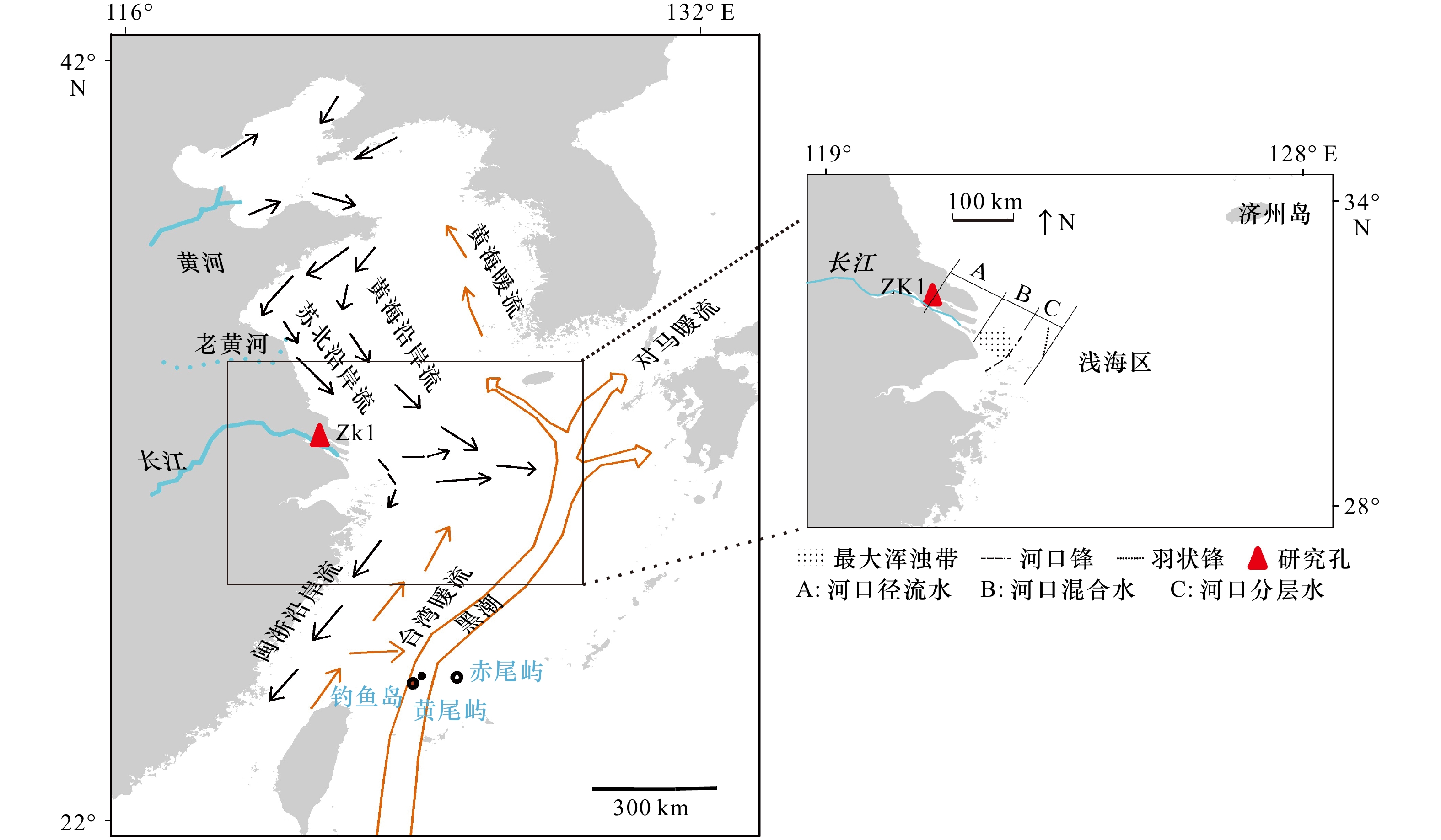
 下载:
下载:
